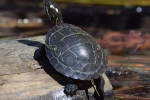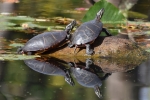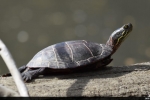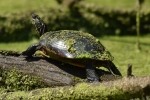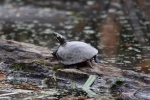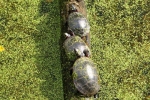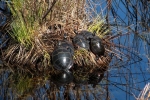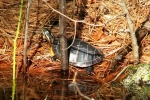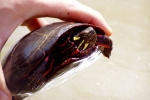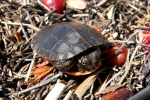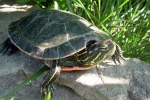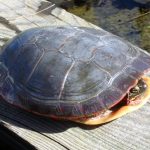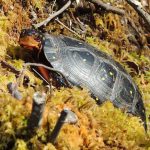Eastern Painted Turtle

Scientific Name: Chrysemys picta picta
Size: 4.5-8 inches (10-18 cm) in length
Status: Abundant
Habitat:
Most all aquatic habitats (except swift streams and standing water with no vegetation) – Slow-moving streams and ditches, small ponds, marshes, small lakes and rivers. Primarily seen basking on logs, stumps and rocks.
Description:
Medium to large sized aquatic species . The upper shell is olive to black in coloration. There is red markings on the shell. The underside is tan to yellow with dark blotches. The legs and tail have yellow or red striping. The head also has yellow stripes with a large yellow spot on either side.
- The carapace is dark olive-green to black.
- The margins of the carapacial scutes are bordered by a thin margin of lighter olive-green.
- The dorsal surface of the marginals are marked with red lines in the form of semicircles, curlicues, bars or crescents; and the underside of the marginals is marked with red bars.
- The plastron is beige to yellow with a variable sized dark central blotch.
- The skin of the legs and tail are black with a pattern of narrow yellow and/or red stripes.
- The head has a yellow stripe extending rearward and may meet a similar stripe from the lower jaw; On each side of the head behind the eyes is a large, yellow dorsolateral spot
- and a yellow streak.
- The chin is marked with two wide yellow stripes that connect at the lower jaw to
- enclose a narrow yellow stripe.
- The upper jaw has red markings.
- Small aquatic species.
- Profile View- The carapace is keel-less and low
- Above View – The carapace is elongate with slightly flaring, unserrated posterior marginals.
- The plastron is large and connects to the carapace by a broad bridge.
- The head is small and the neck is short.
- The tail is short.
- The legs are small and thin.
- The hind feet are broad and fully webbed.
- The shell is more circular in outline with a slight center keel.
- The margins of the scutes are not set off by a thin olive line.
- The tail is very long.


- Eastern – The vertebral and pleural carapacial seams align; Light border along the carapacial seams and an unmarked yellow plastron; The middorsal stripe is narrow or may be absent.
- Midland - The vertebral and pleual carapacial seams are alternating; A dark border along the carapacial seams and a variable dark blotch on the plastron; The middorsal stripe is usually absent.
References:
- Hulse, C. and McCoy C. J. and Ellen Censky ,1998. Amphibians and Reptiles of Pennsylvania and the Northeast. 188-193pp.
- Ernst, Carl H. and Lovich, Jeffrey E., and Barbour, Roger W. ,1994. Turtles of the United States and Canada. 2-18pp.
- Bob Hamilton
- Wayne Fidler
- Rex Everett
- Brandon Curtis
- Kyle Fawcett
- Stephen Staedtler
Heads up!
Please contribute your observation of this and other herps to the Pennsylvania Amphibian and Reptile Survey. Your help is needed.
